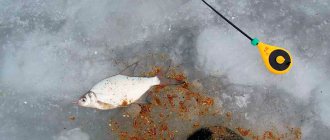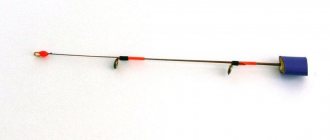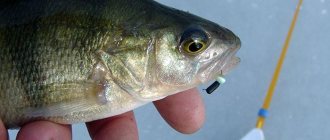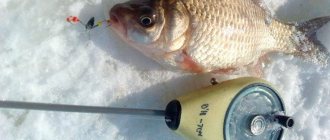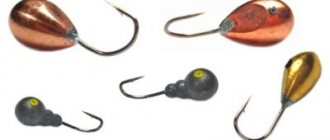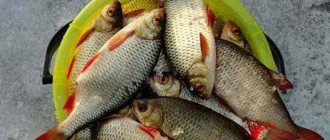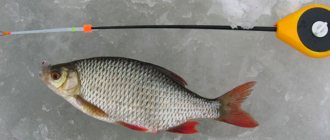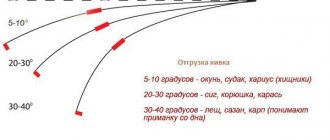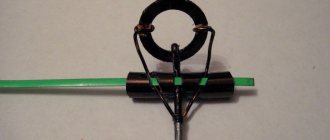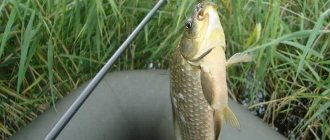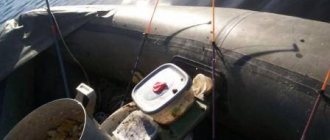Ice fishing has many benefits. For example, you can search for fish almost throughout the entire body of water. Winter gear does not take up much space, it is not heavy, and its components can be easily replaced if necessary.
Equipment for ice fishing in winter can be very inexpensive, although there are clearly not budget models, especially those made in Japan. It is quite possible to make a winter fishing rod yourself, and it may turn out to be even more convenient and catchier than store-bought ones.
But anglers who fish with jigs especially appreciate the opportunity of the so-called game, when it is the movements of the gear in the water that allow them to attract fish of one type or another. This kind of game is a whole science, it is impossible to learn it right away, you need accumulated experience. And you need especially sensitive tackle, the most important part of which is the nod or guard - a device that shows the bite and determines the nature of the jig's game .
What are they for?
We have already almost answered this question - the nod is a bite signal , and it is this that controls the jig . Fish do not show much activity in winter, and often, having noticed an object shiny like the scales of a fry at the bottom or on the bottom, it will not show much interest in it until it begins to move.
These movements should not be sharp and highly amplitude, it looks unnatural. Therefore, if you simply tie a fishing line with a jig at the end to the whip of a winter fishing rod or even to a stick, your fishing is unlikely to work. It is the shock-absorbing, small movements of the jig, which are transmitted to it from the nod, that attract river inhabitants.
As for the bite alarm, in cold winter water this bite can be so weak and cautious that when fishing with a float it can be overlooked. A well- tuned nod will signal even a tentative approach of the fish .
Jig playing style
There are many techniques for moving a jig when fishing for perch. One of them is the combined style - it consists of performing the following actions:
- When the jig collides with the bottom, we raise it 25-30 cm, making oscillations of moderate frequency and amplitude; then we calmly lower the jig to the bottom, but without hesitation.
- We knock the jig on the bottom several times, after which we quietly raise it by 5-6 cm and, when we reach the top point, we stop for 5-10 seconds, after which we return it to the bottom;
- Calmly lift the jig from the bottom by 20 cm and tap the whip with your finger for 20-25 seconds at short intervals.
By repeating such actions we get the perch to bite. If there are no bites, then we change the hole.
Watch a video about catching large perch in winter with a jig:
Types of nods by weight
The nod for a winter fishing rod is selected according to the hardness of the base and the weight of the bait:
- light – up to 0.3 g;
- average – 0.4-0.6 g;
- heavy – 0.7-1 g.
If you know which jigs you will use on your upcoming fishing trip, when choosing a guard, test it on this particular gear.
Expert opinion
Knipovich Nikolai Mikhailovich
Zoologist, hydrobiologist. I am interested in fishing at a professional level.
Important! In water, the jig bends the guard less than in the air, so when purchasing tackle, take this circumstance into account.
Also, nods are selected according to length:
- a fast short guard suitable for catching perch and roach;
- But when going for bream or crucian carp, you should choose a longer form.
It is also necessary to take into account the characteristics of the fishing location:
- soft nods are used when fishing in still water on lakes or ponds;
- medium ones are suitable for any current, but the choice depends on the manner of playing with the jig;
- rigid tackle is used in strong currents and at great depths.
In addition, if you are going to modify the purchased nod, take into account the elasticity and weight, adjusted for this. Surely the weight of the nod and its ability to bend will be significantly reduced.
How to choose the right lodge for winter fishing?
Experienced fishermen carry several different nods with them so that they can select them for different tasks right on the spot. What parameters should you be guided by when choosing?
Selection by weight
A simple rule: the lighter the bait, the softer the nod should be.
Therefore, it is preferable to use metal ones for heavy baits, which have the necessary rigidity and stability. Determining the weight of the bait:
- light - up to 0.3 grams;
- average - about 0.4–0.6 grams;
- heavy - from 0.7 to 1 gram.
Based on these indicators, you can choose a nod.
Reference! When the bait is immersed in water, the bend of the nod should be approximately 45 degrees.
Selection by length
Different lengths determine the speed of the nod and the possibilities of the game. Therefore, for different fish, knowing its preferences, it makes sense to choose different lengths.
Determination of nod length:
- short allows for quick and small games;
- The long one is designed for a quiet leash.
In addition to speed, when choosing a length, you need to remember the weight of the bait; for a light one, choose a short nod, and for a heavy one, choose a long one.
Interesting! Some nods can be adjusted in length, this makes them more versatile.
Load sensitivity selection
The basic principle when checking a nod when loaded is that it should not only bend in the right direction, but also easily return to its original shape. That is why the bite is visible.
Sensitivity definition:
- The standard bending angle for immersed gear is 45 degrees;
- when fishing with a reelless reel, the angle can be about 30 degrees;
- “Devil” or “Goat” baits require a horizontal position, that is, the initial bend of the bite alarm should be upward.
The bending under weight can be adjusted by choosing different stiffness or thickness of the nod. In some cases, there is a need to give it the required bend after immersion; this is possible when using metal.
Choosing a fish house
In addition to weather conditions and characteristics of the reservoir (current speed, depth, bottom irregularities), the most important thing, perhaps, is the selection of a suitable nod for different fish.
Even with the relative universality of many of them, there are still significant differences that determine the choice.
- Perch is a predatory fish; it is active in different ways in winter and is caught with a jig. The bite alarm will need to be long and sensitive, and when fishing with a reelless bait, it will be hard. A silicone or mylar nod is suitable.
- In the middle of winter, roaches will feed at the bottom of the reservoir, in holes. The jig you choose is small, the nod should be sensitive, this fish has weak, unnoticeable bites. Dacron will do.
- In winter, bream mainly feeds at the bottom of the reservoir; its bites are very careful. You will need a long, well-bent nod or a back-bent one. The game for bream is carried out calmly so as not to scare away the fish.
- Pike stay at shallow depths closer to the shore, where the water is less cold. Small fish are caught using a bite alarm. It is best to use a silicone nod-tube, which gives a large bend - “snot”. In case of strong currents, you need to take strong metal nods.
- Pike perch sleeps at the bottom or moves in a flock in search of food. It is caught well with heavy tackle like a “devil”, so the nod needs to be metallic, but sensitive.
Basic selection rules
With baited tackle
Fishing together with a bait is considered classic winter fishing with a jig, and sometimes the jig is simply used as an elevator, lowering the bloodworm or maggot to the required depth.
However, fishing with bait still requires using the game. The gatehouse is selected accordingly:
- To catch perch and quickly play the tackle, it is advisable to choose a guard that bends 25-30 degrees . Usually these are nods made of lavsan; their length is from 5 to 10 cm, no more.
- For slow play and fishing with a bait from the bottom, you need to choose a nod that bends up to 50 degrees . It is this kind of bend that clearly shows the moment when the bait is already touching the bottom, but the jig itself is not yet there; you can gently tap it on the bottom nearby.
With no rewind
This method of fishing involves active play of the tackle, so the nod should provide it. The best sizes for such equipment are a bend of up to 30 degrees and a length of about 10 cm . For beginners, an ordinary cone-type lavsan is suitable; experienced fishermen prefer various designs made from combined materials from the Salmo Whitefish .
Nod spring for fishing rod with jig
The photo shows homemade winter fishing rod nods with spring holders of various designs, intended for guiding jigs and other baits in winter and summer fishing.
The spring of any shock absorber on a fishing rod can be ideally adjusted to the weight in the water of the bait, selected for certain fishing conditions with spoons, balancers, jigs in winter fishing conditions, but, unfortunately, only within certain limits.
For example, on a winter fishing rod with a jig, I would put a nod made of a clock spring with a spring-type shock absorber, the spring of which is obviously designed to be adjusted to the weight in the water of the jig chosen for fishing, or to the characteristics of the bait’s wiring.
For this reason, it is difficult to judge the correct adjustment of the spring system nods from the clock springs shown in the two lower positions of the photo until the shock absorbers are loaded with jigs lowered into the water.
During the filming of the video embedded at the bottom of the page, the nod spring was also adjusted to the weight of each jig.
You will be surprised to what extent you sometimes have to deform the nod spring if even a not very heavy jig is swinging with a winter fishing rod. Pictures with examples of adjusting the nods of the spring system for jigs of different weights are placed below in the text.
The nod shown in the top position of the photo is suitable for catching fish with a winter fishing rod with a heavy jig on a powerful river current, or for trolling with vertical spoons.
But, if we take into account that the nods of winter fishing rods with plastic plates are not subject to adjustment at all, with the exception of the possibility of adjusting the length, then homemade shock absorbers from clock springs can offer them a big head start in terms of adjustment capabilities.
And before we talk about setting up a homemade spring nod from a clock spring for a winter fishing rod, designed for fishing with jigs that have a large variation in weight, I have to make a few clarifications.
Selection by material of manufacture
Metal
These nods do not bend very significantly under the load of the jig - on average by 5-10 degrees . When purchasing such a gatehouse, you need to take into account the following features:
- when fishing without a reel, it does not oscillate in response, so rely only on your constant movements;
- it practically repeats the whip, so the game will have to be played with a relatively large amplitude;
- for catching large fish, it is ideal for a large jig and a small spoon.
Curved
It is usually made from a plastic plate or spring. If the nod is initially bent upward, this is a tackle for slow play near the bottom. And the downward bend is intended for sharp jerks, which usually attract perch.
When choosing such tackle, you can test the straight tackle, and then bend the nod at the desired angle up to 45 degrees .
Lavsan
A lavsan nod is inexpensive, durable, highly sensitive and durable. The disadvantages of such gear include its insufficient frost resistance and poor wind resistance.
Expert opinion
Knipovich Nikolai Mikhailovich
Zoologist, hydrobiologist. I am interested in fishing at a professional level.
Important! If you are going to fish with a light jig, the nod should be modernized by slightly sharpening it at the end and shortening it.
Models with frost-resistant additives are now on sale.
Silicone
Its properties are similar to lavsan, it is sensitive and soft, but you should buy several models for the season. They age quickly and lose their elasticity.
Boar bristles
Our grandfathers also used such nods, now they have been replaced by lavsan. The tackle is sensitive, excellent for working with micro jigs.
However, such clog guards resist cross winds. Therefore, some amateurs thread such tackle through a small spring.
Combined
Consists of a base (plastic) and a metal tip. Combines the advantages and disadvantages of both materials.
Well suited for small, frequent play.
Carbon fiber
Often such nods are made independently from old fishing rods and spinning rods. The tackle resists wind and frost well, but when using different types of carbon fiber, it has a different margin of safety.
"Snot"
You don’t have to buy such a nod; it’s easy to make it yourself. The fishing line is wound onto a rod of small diameter, then boiled in water for several minutes. Then the tube is removed, and the ultra-sensitive gear is ready. Just not very durable.
How to catch perch with a jig in winter
Catching perch with a jig is popular in winter. But there are still more secrets in this matter than simple clarity. Why do some anglers have significant catches of perch using a jig, while...
Are there any special secrets to winter fishing for perch with a jig? How to learn to fish effectively with a jig? Let's look at a few basic techniques for catching perch in winter using a jig.
Winter nod to the jig
A good option for a winter nod, which allows you to create a different jig game, is a long spring-type nod. It is universal in its purpose and allows you to confidently work with the lightest jigs even in difficult weather conditions. Mastering this nod will allow you to obtain a universal weapon for winter fishing, including against sleepy fish.
Choose jigs that are small, but not too small
The characteristic of a good jig is a small size with sufficient weight, as long as it maintains controllability and clear play. Very miniature specimens of micro jigs with a body size of 1-1.5 mm do not often justify themselves, since they can only be used in calm weather and at a limited depth. In addition, you will have to use a fishing line with a diameter of 0.08 mm, otherwise the windage will still affect the game.
With such a fishing line there are more problems during active fishing, which eliminates all the advantages of the bait. In addition to the departure of decent fish, breaks are possible due to accidental snags, or when removing a caught perch, and besides, the fishing line has increased tangles. So it’s better to consider fishing with ultra-small jigs as an experiment and as a last resort to stir up underwater inhabitants.
Quiet lures are sometimes irreplaceable
We can distinguish a special class of jigs that behave clearly more passively, emit less sound, and vibrate little. They are also called slow or quiet. Such winter baits include a fly jig, a jig covered with lint, as well as a small nymph, on the forend of which a heavy bead or a large cambric is put on. The sound can be loud, but its frequency is minimal.
On some days, these quiet jigs are simply irreplaceable. This class of bait is a must-have in the angler’s arsenal. When the fish does not bite, replacing jigs usually leads to a decrease in frequency and noise. Fishing begins with the fastest one, then the bait is gradually changed to the slowest one, which is usually what tempts the sleepy perch.
Perch is more often caught with a jig, especially in the dead of winter, when the fish are sluggish
Catching passive perch
Perch can be especially passive at any time in winter, both on the first ice and before ice drift, since the behavior of the fish is influenced by many different factors. The periodic passivity of perch forces anglers to look for special approaches to catching it.
In this case, playing fast and aggressively with bait will not help. The game technique for catching passive perch is as follows.
- Slow lifting from the ground and slow lowering with a minimum of vibrations. Lowering can be done with pauses of 1-2 seconds. Between these cycles, the jig lies on the ground for 2–4 seconds.
Inspecting a new hole with a jig
It is better to start examining the next hole with more active movements: hitting the bottom with the jig 3-4 times with an interval of 1 second. If there is no quick bite, then after letting the jig lie for 2-4 seconds, you can begin slow lifts.
During such fishing, it is useful to gradually increase the pause the jig remains on the bottom after each lowering to 15 seconds. If 8 cycles are done and there is no bite, then you need to change the bait or hole.
Where there is a current, you can use its strength. The jig is allowed to lie on the bottom for up to 5-7 seconds, during which time it drifts a little, which also attracts passive fish.
How to entice a passive perch
If the perch indicates its presence, makes pokes, but is not caught, you can tease it with a faster retrieve, make several lifts with frequency play, and then move on to a slow retrieve, which should give results.
Another technique for examining the hole when the perch is passive:
- Place the jig on the ground and wait up to half a minute, then very slowly lift the bait above the bottom to a height of up to 10 cm, vibrating with a nod in the horizontal plane.
This start can be followed by the usual slow rises of the bait.
Catching perch in the middle of nowhere
In the dead of winter, the fish are sluggish. Usually the perch just twitches the jig and pokes its nose into it. This is expressed in frequent small twitches of the nod. But cutting leads to nothing. It is better to change such a hole.
A real bite, when the perch slowly retracts the bait, is expressed in the slow sagging of the nod. In the wilderness, you will most often need micro jigs, despite all the difficulties of working with them, as well as narrow-bodied jigs that vibrate little on their own, and equipped with an edge or with a hinge of disks and beads.
Game in the wilderness
The game in the wilderness should be even smoother and with longer pauses of up to 10 seconds.
Another trick for seducing sluggish winter perch,
- The jig is thrown 2-5 cm with a sharp rise of the nod, after which it hangs in its original position for up to 15 seconds. The bite usually occurs immediately after the jig returns to the horizon.
Catching perch with a jig at the end of winter
At the end of February, at the beginning of March, when the melt water goes under the ice, all the fish show increased activity and rush closer to the shore. It is also necessary for the angler to change his approaches to catching perch compared to the wilderness.
As a rule, in spring perch does not tend to grab large objects. Perhaps because by spring the fish are full of eggs. To catch it in the spring, it is better to prepare the smallest jigs, but this time you can use louder ones.
- The smallest baits that imitate amphipods, as well as dark fishing lines, work better.
Suitable jig game in spring
The most suitable style of playing with lures is a constant change of style from slow to fast and frequency. For example, five transactions are done at a fast pace, and the next five at a slow pace.
One of the techniques for catching perch in the spring:
- freezing of the bait at the top point of the retrieve. A smooth rise is made, then the jig lingers at the top point for up to 10 seconds, then smoothly lowers. The spring perch bite often occurs at the top point of the retrieve or at the beginning of the descent.
The next method of wiring is the vibrational lifting of a ringing jig.
- Raising up to half a meter in height can last a full minute, but during this movement the nod should tremble and disturb the jig.
In any case, selecting a working jig, and the manner of playing with it, takes time, and therefore frequent fishing trips. The techniques described here are just a basic start to the fun of finding your way to big catches.
Which to choose
Each gear has its own advantages, but some of them should be highlighted:
- more durable nods made of metal, carbon fiber or clock spring allow you to fish at great depths and with larger baits and jigs, but they are not suitable for shallow game;
- universal sensitive and durable material - lavsan, but it is poorly resistant to side winds;
- for small games, use nods even from welded fishing line (snot) or nipple, but do not count on their great strength.
Jigs
Lead, tin or tungsten are used to make jigs. Tungsten baits are the priority for perch. Often lead products have a slightly dull hook. Jigs work for predators in the form of:
- drops;
- rhombus;
- circle;
- banana;
- flies and other insects.
It is better to choose the color of the jig from natural ones. It is impossible to immediately identify the preferences of a predator; here you need to experiment. In the dead of winter, when fishing for perch at a depth of up to 1.5 m, versions of dark tones, as well as silver-dark ones, will be attracted. At a depth of over 2 meters, silver, golden and yellow baits will be effective. If there is no reaction from the perch to them, you can try your luck with bright jigs.
On the first ice for perch, the weight of the jig should be 0.3-0.4 grams. During these periods of winter, fish respond better to large baits of 3–4 and 5 mm. They are clearly visible in the water, and the game turns out to be interesting, and the tackle sinks faster.
Thin rigs work against a passive predator. The size of the bait is no more than 2-2.8 mm, which is 0.2-0.3 g. They are used at a depth of up to 6 m. Devils and witches are very popular among winter anglers. The first are jigs, which, in addition to one solid hook, are also equipped with a tee, and the second have 4 hooks, fastened with a wire frame.
Catching perch in winter with a jig is an exciting activity that requires constant movement around the reservoir. It is better to drill holes in a checkerboard pattern, maintaining a distance of 5–10 m between them. The main thing is to prevent the drill from coming into contact with the ground, otherwise the knives will quickly become dull. To increase your chances of catching, it is worth having different baits and a bait mixture that is attractive to predators.
Refinement and customization
The game of the jig can be adjusted by lengthening or shortening the guard . Some store-bought models have special length adjusters, but you shouldn’t rely on them too much - in the cold such mechanisms often simply jam.
Dacron gatehouses are especially subject to modification. Usually the tip is sharpened to extreme fineness to give great sensitivity. Some models do not have a taper, but they are also added. Often, nods made of silicone or lavsan are sold without additional painting. In this case, it is recommended to apply several notches to the structure with nail polish - this way the nod will be more noticeable against the background of ice and snow.
Winter lodges, which ones are best to use?
Winter guards are very useful when fishing if you often move and change holes with different depths. The gatehouse is usually made from a long plate of spring metal or polymer. Winter guardhouses should be no more than 15 cm, width 3 mm, thickness 0.15 mm. You need to attach a ring to the end of the guard; cambrics are not suitable, as they are frayed by fishing line. The cambric must be placed in the middle of the guard as a passage ring. At the end of the cambric that will be attached to the fishing rod you need to put a connecting ring, a ring from a braid of thick wires will do.
Depending on the bait and the expected fish caught, guards are also selected. Gatehouses are made from springs of different thicknesses. For small baits, guards are made from a coiled spring. They are thinner, which is why they vibrate strongly in the wind and last less. Also, gatehouses of different thicknesses can be made from a sheet of lavsan. Which bends well and withstands low temperatures. Winter guards are designed to transmit a bite signal, but are in no way designed to transmit vibrations to the bait. He does this poorly and will only scare away the fish. Winter nods are used to transmit vibrations to the bait.
